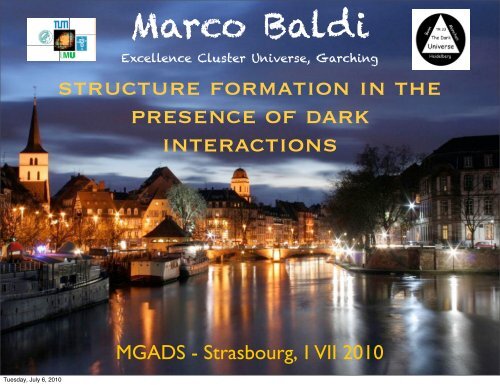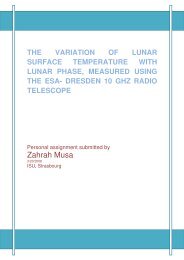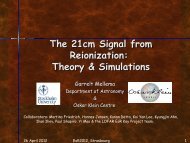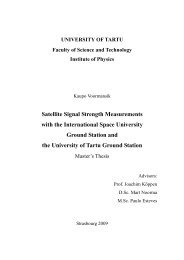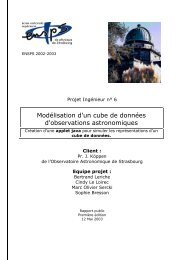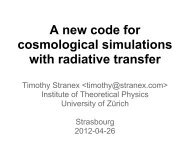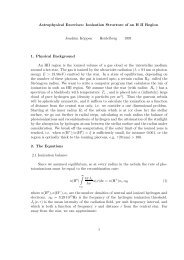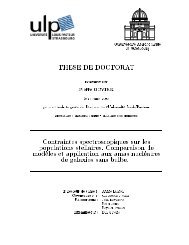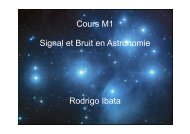Marco Baldi
Marco Baldi
Marco Baldi
Create successful ePaper yourself
Turn your PDF publications into a flip-book with our unique Google optimized e-Paper software.
Tuesday, July 6, 2010<br />
<strong>Marco</strong> <strong>Baldi</strong><br />
Excellence Cluster Universe, Garching<br />
structure formation in the<br />
presence of dark<br />
interactions<br />
MGADS - Strasbourg, 1 VII 2010
Introduction<br />
outline<br />
Standard Model and non-standard models of the Universe<br />
Dynamic and interacting DE:<br />
- constant couplings [MB, V. Pettorino, G. Robbers, V. Springel - 0812.3901 (2010)]<br />
- time dependent couplings [MB - 1005.2188]<br />
Numerical methods for N-body simulations of interacting dark energy<br />
- assumptions, approximations, and their range of validity<br />
Results from high-resolution N-body runs:<br />
- Large Scale Structure: Halo Mass Function [MB, V. Pettorino - 1006.3761], Bias<br />
- Collapsed objects: Density Profiles, Concentrations, Baryon Fraction<br />
Next steps in a resurrected topic<br />
Tuesday, July 6, 2010<br />
<strong>Marco</strong> <strong>Baldi</strong> - MGADS, Strasbourg 16 VI 2010
The beginning of the story: evidence for DE<br />
The last decade (well, actually a bit more than that...) has provided<br />
us with a hardly doubtable evidence of the existence of some<br />
accelerating component in the Universe, dubbed Dark Energy<br />
Tuesday, July 6, 2010<br />
<strong>Marco</strong> <strong>Baldi</strong> - MGADS, Strasbourg 16 VI 2010
The beginning of the story: evidence for DE<br />
The last decade (well, actually a bit more than that...) has provided<br />
us with a hardly doubtable evidence of the existence of some<br />
accelerating component in the Universe, dubbed Dark Energy<br />
Tuesday, July 6, 2010<br />
Large Scale Structure<br />
[APM, 2dF, SDSS, ...]<br />
Supernovae Ia<br />
[high-z SNS, SN Cosmology Project, ...]<br />
CMB anisotropies<br />
[COBE, WMAP, ...]<br />
Gravitational Lensing<br />
[HST, ...]<br />
<strong>Marco</strong> <strong>Baldi</strong> - MGADS, Strasbourg 16 VI 2010
The beginning of the story: evidence for DE<br />
The last decade (well, actually a bit more than that...) has provided<br />
us with a hardly doubtable evidence of the existence of some<br />
accelerating component in the Universe, dubbed Dark Energy<br />
Large Scale Structure<br />
[APM, 2dF, SDSS, ...]<br />
Supernovae Ia<br />
[high-z SNS, SN Cosmology Project, ...]<br />
CMB anisotropies<br />
[COBE, WMAP, ...]<br />
Gravitational Lensing<br />
[HST, ...]<br />
The theoretical effort to cast all these data into a simple and<br />
consistent picture of the Universe has led to the establishment of a<br />
STANDARD MODEL...<br />
Tuesday, July 6, 2010<br />
<strong>Marco</strong> <strong>Baldi</strong> - MGADS, Strasbourg 16 VI 2010
The beginning of the story: evidence for DE<br />
The last decade (well, actually a bit more than that...) has provided<br />
us with a hardly doubtable evidence of the existence of some<br />
accelerating component in the Universe, dubbed Dark Energy<br />
Large Scale Structure<br />
[APM, 2dF, SDSS, ...]<br />
Supernovae Ia<br />
[high-z SNS, SN Cosmology Project, ...]<br />
CMB anisotropies<br />
[COBE, WMAP, ...]<br />
Gravitational Lensing<br />
[HST, ...]<br />
The theoretical effort to cast all these data into a simple and<br />
consistent picture of the Universe has led to the establishment of a<br />
STANDARD MODEL...<br />
Tuesday, July 6, 2010<br />
<strong>Marco</strong> <strong>Baldi</strong> - MGADS, Strasbourg 16 VI 2010
Tuesday, July 6, 2010<br />
Standard model and non-standard models<br />
<strong>Marco</strong> <strong>Baldi</strong> - MGADS, Strasbourg 16 VI 2010
Standard model and non-standard models<br />
Which is the standard model?<br />
Tuesday, July 6, 2010<br />
<strong>Marco</strong> <strong>Baldi</strong> - MGADS, Strasbourg 16 VI 2010
Standard model and non-standard models<br />
Which is the standard model?<br />
Tuesday, July 6, 2010<br />
ΛCDM<br />
<strong>Marco</strong> <strong>Baldi</strong> - MGADS, Strasbourg 16 VI 2010
Standard model and non-standard models<br />
Which is the standard model?<br />
Tuesday, July 6, 2010<br />
ΛCDM<br />
1) GR is the correct and complete theory of gravity<br />
<strong>Marco</strong> <strong>Baldi</strong> - MGADS, Strasbourg 16 VI 2010
Standard model and non-standard models<br />
Which is the standard model?<br />
Tuesday, July 6, 2010<br />
ΛCDM<br />
1) GR is the correct and complete theory of gravity<br />
2) The Cosmological Principle holds (FLRW metric)<br />
<strong>Marco</strong> <strong>Baldi</strong> - MGADS, Strasbourg 16 VI 2010
Standard model and non-standard models<br />
Which is the standard model?<br />
Tuesday, July 6, 2010<br />
ΛCDM<br />
1) GR is the correct and complete theory of gravity<br />
2) The Cosmological Principle holds (FLRW metric)<br />
3) The acceleration of the Universe is driven by a Cosmological Constant<br />
<strong>Marco</strong> <strong>Baldi</strong> - MGADS, Strasbourg 16 VI 2010
Standard model and non-standard models<br />
Which is the standard model?<br />
ΛCDM<br />
1) GR is the correct and complete theory of gravity<br />
2) The Cosmological Principle holds (FLRW metric)<br />
3) The acceleration of the Universe is driven by a Cosmological Constant<br />
What is a non-standard model?<br />
Tuesday, July 6, 2010<br />
<strong>Marco</strong> <strong>Baldi</strong> - MGADS, Strasbourg 16 VI 2010
Standard model and non-standard models<br />
Which is the standard model?<br />
ΛCDM<br />
1) GR is the correct and complete theory of gravity<br />
What is a non-standard model?<br />
Tuesday, July 6, 2010<br />
2) The Cosmological Principle holds (FLRW metric)<br />
3) The acceleration of the Universe is driven by a Cosmological Constant<br />
Anything ≠ ΛCDM<br />
<strong>Marco</strong> <strong>Baldi</strong> - MGADS, Strasbourg 16 VI 2010
Standard model and non-standard models<br />
Which is the standard model?<br />
ΛCDM<br />
1) GR is the correct and complete theory of gravity<br />
What is a non-standard model?<br />
Tuesday, July 6, 2010<br />
2) The Cosmological Principle holds (FLRW metric)<br />
3) The acceleration of the Universe is driven by a Cosmological Constant<br />
Anything ≠ ΛCDM<br />
Dropping 1) Modified Gravities (ST theories, f(R) theories, TeVeS, extra dimensions, String...)<br />
<strong>Marco</strong> <strong>Baldi</strong> - MGADS, Strasbourg 16 VI 2010
Standard model and non-standard models<br />
Which is the standard model?<br />
ΛCDM<br />
1) GR is the correct and complete theory of gravity<br />
What is a non-standard model?<br />
Tuesday, July 6, 2010<br />
2) The Cosmological Principle holds (FLRW metric)<br />
3) The acceleration of the Universe is driven by a Cosmological Constant<br />
Anything ≠ ΛCDM<br />
Dropping 1) Modified Gravities (ST theories, f(R) theories, TeVeS, extra dimensions, String...)<br />
Dropping 2) Inhomogeneous Universe (LTB models, Backreaction, ...)<br />
<strong>Marco</strong> <strong>Baldi</strong> - MGADS, Strasbourg 16 VI 2010
Standard model and non-standard models<br />
Which is the standard model?<br />
ΛCDM<br />
1) GR is the correct and complete theory of gravity<br />
What is a non-standard model?<br />
Tuesday, July 6, 2010<br />
2) The Cosmological Principle holds (FLRW metric)<br />
3) The acceleration of the Universe is driven by a Cosmological Constant<br />
Anything ≠ ΛCDM<br />
Dropping 1) Modified Gravities (ST theories, f(R) theories, TeVeS, extra dimensions, String...)<br />
Dropping 2) Inhomogeneous Universe (LTB models, Backreaction, ...)<br />
Dropping 3)<br />
Dynamic Dark Energy models (Quintessence, k-essence, phantom, ...)<br />
Interactions of Dark Energy (Coupled DE, Unified DM, Chaplygin gas, ...)<br />
<strong>Marco</strong> <strong>Baldi</strong> - MGADS, Strasbourg 16 VI 2010
Why bothering with non-standard models? (I)<br />
The “standard” model is standard for a reason:<br />
Tuesday, July 6, 2010<br />
<strong>Marco</strong> <strong>Baldi</strong> - MGADS, Strasbourg 16 VI 2010
Why bothering with non-standard models? (I)<br />
The “standard” model is standard for a reason:<br />
fits well most of the data<br />
Tuesday, July 6, 2010<br />
<strong>Marco</strong> <strong>Baldi</strong> - MGADS, Strasbourg 16 VI 2010
Why bothering with non-standard models? (I)<br />
The “standard” model is standard for a reason:<br />
fits well most of the data easy<br />
Tuesday, July 6, 2010<br />
<strong>Marco</strong> <strong>Baldi</strong> - MGADS, Strasbourg 16 VI 2010
Why bothering with non-standard models? (I)<br />
The “standard” model is standard for a reason:<br />
fits well most of the data easy<br />
Tuesday, July 6, 2010<br />
<strong>Marco</strong> <strong>Baldi</strong> - MGADS, Strasbourg 16 VI 2010<br />
economic
Why bothering with non-standard models? (I)<br />
The “standard” model is standard for a reason:<br />
fits well most of the data easy<br />
So why looking for something more “exotic”?<br />
Tuesday, July 6, 2010<br />
<strong>Marco</strong> <strong>Baldi</strong> - MGADS, Strasbourg 16 VI 2010<br />
economic
Why bothering with non-standard models? (I)<br />
The “standard” model is standard for a reason:<br />
fits well most of the data easy<br />
So why looking for something more “exotic”?<br />
Easy BUT highly fine-tuned (cosmological issues):<br />
1) Only one number (Λ) but unnaturally small: FINE TUNING<br />
2) Λ domination is very recent: COINCIDENCE<br />
Tuesday, July 6, 2010<br />
ρΛ<br />
ρm<br />
<strong>Marco</strong> <strong>Baldi</strong> - MGADS, Strasbourg 16 VI 2010<br />
economic<br />
ρΛ<br />
ρpl<br />
∼ 10 −123<br />
< 10 −3 for z > 6
Why bothering with non-standard models? (II)<br />
NOT everything fits (astrophysical issues):<br />
1) Cusp-Core problem: OBSERVED CDM HALOS SHALLOWER THAN NFW<br />
[e.g. Flores & Primack 1994, Salucci & Burkert 2000, Newman et al. 2009]<br />
2) Satellite Problem: MANY FEWER SATELLITES OBSERVED THAN PREDICTED<br />
[e.g. Klypin et al. 1999, Springel 2008, (but see also e.g Maccio’ et al. 2009 MAYBE SOLVED?)]<br />
3) Void Phenomenon: TOO FEW GALAXIES FOUND IN VOIDS<br />
[e.g. Peebles 2000, Peebles & Nusser 2010]<br />
4) Cluster Baryon Fraction: SYSTEMATICALLY LOWER THAN EXPECTED<br />
[e.g. Allen et al. 2006 (but see also Giodini et al 2009!!)]<br />
5) Bulk Flows: TOO LARGE GALAXY VELOCITIES ON LARGE SCALES<br />
[e.g. Watkins et al. 2008, (but see also Erdogdu & Lahav 2009)]<br />
6) High-z massive clusters: VERY UNLIKELY TO FORM IN ΛCDM<br />
[e.g. Jee et al. 2009, Rosati et al 2009]<br />
7) The Bullet Cluster: EXCEEDINGLY RARE OBJECT IN A ΛCDM UNIVERSE<br />
[Lee & Komatsu 2010]<br />
Tuesday, July 6, 2010<br />
<strong>Marco</strong> <strong>Baldi</strong> - MGADS, Strasbourg 16 VI 2010
Dynamic and interacting<br />
Dynamic DE: a scalar field in a self-interaction potential<br />
Tuesday, July 6, 2010<br />
<strong>Marco</strong> <strong>Baldi</strong> - MGADS, Strasbourg 16 VI 2010
Dynamic and interacting<br />
Dynamic DE: a scalar field in a self-interaction potential<br />
¨φ +3H ˙ φ + dV<br />
dφ =0<br />
Tuesday, July 6, 2010<br />
[Wetterich 1988]<br />
<strong>Marco</strong> <strong>Baldi</strong> - MGADS, Strasbourg 16 VI 2010
Tuesday, July 6, 2010<br />
Time dependent couplings [MB 1005.2188]<br />
<strong>Marco</strong> <strong>Baldi</strong> - MGADS, Strasbourg 16 VI 2010
Time dependent couplings [MB 1005.2188]<br />
Why consider time variations of the coupling?<br />
Tuesday, July 6, 2010<br />
<strong>Marco</strong> <strong>Baldi</strong> - MGADS, Strasbourg 16 VI 2010
Time dependent couplings [MB 1005.2188]<br />
Why consider time variations of the coupling?<br />
1) There is no reason why β should be a constant. β(ϕ) is a more natural assumption<br />
2) A varying (growing) β could have larger effects on astrophysical observables at late<br />
times with a weaker impact on CMB and background expansion: INTERESTING.<br />
Tuesday, July 6, 2010<br />
<strong>Marco</strong> <strong>Baldi</strong> - MGADS, Strasbourg 16 VI 2010
Time dependent couplings [MB 1005.2188]<br />
Why consider time variations of the coupling?<br />
1) There is no reason why β should be a constant. β(ϕ) is a more natural assumption<br />
2) A varying (growing) β could have larger effects on astrophysical observables at late<br />
times with a weaker impact on CMB and background expansion: INTERESTING.<br />
What changes with a time dependent coupling?<br />
Tuesday, July 6, 2010<br />
<strong>Marco</strong> <strong>Baldi</strong> - MGADS, Strasbourg 16 VI 2010
Time dependent couplings [MB 1005.2188]<br />
Why consider time variations of the coupling?<br />
1) There is no reason why β should be a constant. β(ϕ) is a more natural assumption<br />
2) A varying (growing) β could have larger effects on astrophysical observables at late<br />
times with a weaker impact on CMB and background expansion: INTERESTING.<br />
What changes with a time dependent coupling?<br />
There is no general analytic solution.<br />
Assume some generic forms of coupling evolution and find numerical solutions:<br />
Tuesday, July 6, 2010<br />
<strong>Marco</strong> <strong>Baldi</strong> - MGADS, Strasbourg 16 VI 2010
Time dependent couplings [MB 1005.2188]<br />
Why consider time variations of the coupling?<br />
1) There is no reason why β should be a constant. β(ϕ) is a more natural assumption<br />
2) A varying (growing) β could have larger effects on astrophysical observables at late<br />
times with a weaker impact on CMB and background expansion: INTERESTING.<br />
What changes with a time dependent coupling?<br />
There is no general analytic solution.<br />
Assume some generic forms of coupling evolution and find numerical solutions:<br />
Tuesday, July 6, 2010<br />
<strong>Marco</strong> <strong>Baldi</strong> - MGADS, Strasbourg 16 VI 2010<br />
β = β0a β1<br />
β = β0e β1φ/M
Time dependent couplings [MB 1005.2188]<br />
Why consider time variations of the coupling?<br />
1) There is no reason why β should be a constant. β(ϕ) is a more natural assumption<br />
2) A varying (growing) β could have larger effects on astrophysical observables at late<br />
times with a weaker impact on CMB and background expansion: INTERESTING.<br />
What changes with a time dependent coupling?<br />
There is no general analytic solution.<br />
Assume some generic forms of coupling evolution and find numerical solutions:<br />
<br />
1.000<br />
0.100<br />
0.010<br />
Background evolution<br />
MDE<br />
Growing MDE<br />
0.001<br />
-10 -8 -6 -4 -2 0<br />
N ln a<br />
Tuesday, July 6, 2010<br />
RP5 in <strong>Baldi</strong> et al. (2010)<br />
EXP010a2<br />
EXP015a3<br />
EXP010e2<br />
EXP010e3<br />
EXP015e3<br />
w <br />
1.0<br />
0.5<br />
0.0<br />
-0.5<br />
-1.0<br />
Equation of state<br />
RP5 in <strong>Baldi</strong> et al. (2010)<br />
EXP010a2<br />
EXP015a3<br />
EXP010e2<br />
EXP010e3<br />
EXP015e3<br />
1 10<br />
z + 1<br />
<strong>Marco</strong> <strong>Baldi</strong> - MGADS, Strasbourg 16 VI 2010<br />
β = β0a β1<br />
β = β0e β1φ/M
Tuesday, July 6, 2010<br />
Features of interacting dark energy<br />
<strong>Marco</strong> <strong>Baldi</strong> - MGADS, Strasbourg 16 VI 2010
Features of interacting dark energy<br />
1) MASS VARIATION<br />
of coupled matter particles<br />
Tuesday, July 6, 2010<br />
<strong>Marco</strong> <strong>Baldi</strong> - MGADS, Strasbourg 16 VI 2010
m c<br />
Features of interacting dark energy<br />
1) MASS VARIATION<br />
of coupled matter particles<br />
1.4<br />
1.3<br />
1.2<br />
1.1<br />
1.0<br />
Mass correction for different coupled dark energy models<br />
CDM ( = 0, c=0)<br />
RP1 ( = 0.143, c=0.04)<br />
RP2 ( = 0.143, c=0.08)<br />
RP3 ( = 0.143, c=0.12)<br />
RP4 ( = 0.143, c=0.16)<br />
RP5 ( = 0.143, c=0.2)<br />
0.9<br />
0 10 20 30 40 50<br />
z<br />
Tuesday, July 6, 2010<br />
<strong>Marco</strong> <strong>Baldi</strong> - MGADS, Strasbourg 16 VI 2010
m c<br />
1.4<br />
1.3<br />
1.2<br />
1.1<br />
1.0<br />
Features of interacting dark energy<br />
1) MASS VARIATION<br />
of coupled matter particles<br />
Mass correction for different coupled dark energy models<br />
CDM ( = 0, c=0)<br />
RP1 ( = 0.143, c=0.04)<br />
RP2 ( = 0.143, c=0.08)<br />
RP3 ( = 0.143, c=0.12)<br />
RP4 ( = 0.143, c=0.16)<br />
RP5 ( = 0.143, c=0.2)<br />
0.9<br />
0 10 20 30 40 50<br />
z<br />
Tuesday, July 6, 2010<br />
<strong>Marco</strong> <strong>Baldi</strong> - MGADS, Strasbourg 16 VI 2010<br />
2) MODIFIED EXPANSION<br />
due to the Early DE component
m c<br />
1.4<br />
1.3<br />
1.2<br />
1.1<br />
1.0<br />
Features of interacting dark energy<br />
1) MASS VARIATION<br />
of coupled matter particles<br />
Mass correction for different coupled dark energy models<br />
CDM ( = 0, c=0)<br />
RP1 ( = 0.143, c=0.04)<br />
RP2 ( = 0.143, c=0.08)<br />
RP3 ( = 0.143, c=0.12)<br />
RP4 ( = 0.143, c=0.16)<br />
RP5 ( = 0.143, c=0.2)<br />
0.9<br />
0 10 20 30 40 50<br />
z<br />
Tuesday, July 6, 2010<br />
2) MODIFIED EXPANSION<br />
due to the Early DE component<br />
3•10 4<br />
2•10 4<br />
1•10 4<br />
<strong>Marco</strong> <strong>Baldi</strong> - MGADS, Strasbourg 16 VI 2010<br />
H (km s -1 Mpc -1 )<br />
Hubble functions for different coupled dark energy models<br />
CDM ( = 0, c=0)<br />
RP1 ( = 0.143, c=0.04)<br />
RP2 ( = 0.143, c=0.08)<br />
RP3 ( = 0.143, c=0.12)<br />
RP4 ( = 0.143, c=0.16)<br />
RP5 ( = 0.143, c=0.2)<br />
0 20 40 60 80 100<br />
z
Tuesday, July 6, 2010<br />
How to implement all this in a code? (III)<br />
<strong>Marco</strong> <strong>Baldi</strong> - MGADS, Strasbourg 16 VI 2010
Tuesday, July 6, 2010<br />
How to implement all this in a code? (III)<br />
Particle-Particle<br />
+<br />
Particle-Mesh<br />
=<br />
GADGET-3<br />
<strong>Marco</strong> <strong>Baldi</strong> - MGADS, Strasbourg 16 VI 2010
Results (I): halo mass function and cluster counts<br />
Number counts in coupled dark energy models: CONSTANT and<br />
VARIABLE couplings [MB & V. Pettorino, 1006.3761]<br />
The recent detection [Jee et al (2009)] of a massive custer at z~1.4 might be a challenge for the<br />
standard model: the probability of such an object in ΛCDM has been estimated to be ~0.005.<br />
N(>M) (h -1 Mpc) -3<br />
N/N CDM<br />
10 -3<br />
10 -4<br />
10 -5<br />
10 -6<br />
10 -7<br />
10.0<br />
1.0<br />
0.1<br />
10 12<br />
Tuesday, July 6, 2010<br />
N=256 3<br />
L=320Mpc/h<br />
DM only<br />
M max=3.05E+15<br />
M max=1.46E+15<br />
M max=9.56E+14<br />
z = 0.0<br />
10 13<br />
10 14<br />
MFoF [h -1 M O•<br />
]<br />
= 0.25<br />
= 0.5 e 2<br />
CDM<br />
10 15<br />
10 16<br />
Maybe non gaussianity?<br />
[Jimenez&Verde (2009)]<br />
NEED A LARGE fNL (~300)<br />
<strong>Marco</strong> <strong>Baldi</strong> - MGADS, Strasbourg 16 VI 2010<br />
INTERACTING DE:<br />
The extra force acting between CDM<br />
particles and the extra friction term<br />
determine a faster growth of density<br />
perturbations.<br />
The number density of halos above a<br />
given mass M at any redshift z is<br />
correspondingly enhanced.
Results (II): bias<br />
The fifth-force determines an “effective” violation of the Weak<br />
Equivalence Principle for CONSTANT and VARIABLE couplings<br />
Tuesday, July 6, 2010<br />
<strong>Marco</strong> <strong>Baldi</strong> - MGADS, Strasbourg 16 VI 2010<br />
N=2x512 3 , L=80Mpc/h, Hydro
Results (II): bias<br />
The fifth-force determines an “effective” violation of the Weak<br />
Equivalence Principle for CONSTANT and VARIABLE couplings<br />
R(k)/R CDM(k)<br />
1.0<br />
0.9<br />
0.8<br />
0.7<br />
0.6<br />
Tuesday, July 6, 2010<br />
CDM CDM CDM CDM CDM CDM CDM CDM CDM CDM CDM CDM CDM CDM CDM CDM CDM CDM<br />
EXP010a2<br />
EXP015a3<br />
EXP010e2<br />
EXP010e3<br />
EXP015e3<br />
0.1 1.0 10.0 100.0<br />
k [ h Mpc -1 z=3.00000<br />
0.5<br />
]<br />
<strong>Marco</strong> <strong>Baldi</strong> - MGADS, Strasbourg 16 VI 2010<br />
GRAVITATIONAL BIAS<br />
Since baryons are not coupled<br />
they do not feel any fifth-force.<br />
Baryon and CDM perturbations<br />
grow with a different rate, and the<br />
two components develop a purely<br />
gravitational bias at all scales.<br />
The bias is enhanced by<br />
nonlinearities at small scales and<br />
grows with time.<br />
N=2x512 3 , L=80Mpc/h, Hydro
The fifth-force determines an “effective” violation of the Weak<br />
Equivalence Principle for CONSTANT and VARIABLE couplings<br />
R(k)/R CDM(k)<br />
1.0<br />
0.9<br />
0.8<br />
0.7<br />
0.6<br />
Tuesday, July 6, 2010<br />
CDM CDM CDM CDM CDM CDM CDM CDM CDM CDM CDM CDM CDM CDM CDM CDM CDM CDM<br />
EXP010a2<br />
EXP015a3<br />
EXP010e2<br />
EXP010e3<br />
EXP015e3<br />
Results (II): bias<br />
0.1 1.0 10.0 100.0<br />
k [ h Mpc -1 z=1.00000<br />
0.5<br />
]<br />
<strong>Marco</strong> <strong>Baldi</strong> - MGADS, Strasbourg 16 VI 2010<br />
GRAVITATIONAL BIAS<br />
Since baryons are not coupled<br />
they do not feel any fifth-force.<br />
Baryon and CDM perturbations<br />
grow with a different rate, and the<br />
two components develop a purely<br />
gravitational bias at all scales.<br />
The bias is enhanced by<br />
nonlinearities at small scales and<br />
grows with time.<br />
N=2x512 3 , L=80Mpc/h, Hydro
The fifth-force determines an “effective” violation of the Weak<br />
Equivalence Principle for CONSTANT and VARIABLE couplings<br />
R(k)/R CDM(k)<br />
1.0<br />
0.9<br />
0.8<br />
0.7<br />
0.6<br />
Tuesday, July 6, 2010<br />
CDM CDM CDM CDM CDM CDM CDM CDM CDM CDM CDM CDM CDM CDM CDM CDM CDM CDM<br />
EXP010a2<br />
EXP015a3<br />
EXP010e2<br />
EXP010e3<br />
EXP015e3<br />
Results (II): bias<br />
0.1 1.0 10.0 100.0<br />
k [ h Mpc -1 z=0.200000<br />
0.5<br />
]<br />
<strong>Marco</strong> <strong>Baldi</strong> - MGADS, Strasbourg 16 VI 2010<br />
GRAVITATIONAL BIAS<br />
Since baryons are not coupled<br />
they do not feel any fifth-force.<br />
Baryon and CDM perturbations<br />
grow with a different rate, and the<br />
two components develop a purely<br />
gravitational bias at all scales.<br />
The bias is enhanced by<br />
nonlinearities at small scales and<br />
grows with time.<br />
N=2x512 3 , L=80Mpc/h, Hydro
The fifth-force determines an “effective” violation of the Weak<br />
Equivalence Principle for CONSTANT and VARIABLE couplings<br />
R(k)/R CDM(k)<br />
1.0<br />
0.9<br />
0.8<br />
0.7<br />
0.6<br />
Tuesday, July 6, 2010<br />
CDM CDM CDM CDM CDM CDM CDM CDM CDM CDM CDM CDM CDM CDM CDM CDM CDM CDM<br />
EXP010a2<br />
EXP015a3<br />
EXP010e2<br />
EXP010e3<br />
EXP015e3<br />
Results (II): bias<br />
0.1 1.0 10.0 100.0<br />
k [ h Mpc -1 z=0.00000<br />
0.5<br />
]<br />
<strong>Marco</strong> <strong>Baldi</strong> - MGADS, Strasbourg 16 VI 2010<br />
GRAVITATIONAL BIAS<br />
Since baryons are not coupled<br />
they do not feel any fifth-force.<br />
Baryon and CDM perturbations<br />
grow with a different rate, and the<br />
two components develop a purely<br />
gravitational bias at all scales.<br />
The bias is enhanced by<br />
nonlinearities at small scales and<br />
grows with time.<br />
N=2x512 3 , L=80Mpc/h, Hydro
Results (III): baryon fraction<br />
The first hydrodynamical high-resolution N-body simulations for a weak<br />
DE-CDM CONSTANT interaction: [<strong>Baldi</strong> et al., MNRAS 2010]<br />
Tuesday, July 6, 2010<br />
N=2x512 3 , L=80Mpc/h, Hydro<br />
<strong>Marco</strong> <strong>Baldi</strong> - MGADS, Strasbourg 16 VI 2010
Results (III): baryon fraction<br />
The first hydrodynamical high-resolution N-body simulations for a weak<br />
DE-CDM CONSTANT interaction: [<strong>Baldi</strong> et al., MNRAS 2010]<br />
Y b<br />
1.00<br />
0.95<br />
0.90<br />
0.85<br />
0.80<br />
Tuesday, July 6, 2010<br />
Evolution of the relative baryon fraction with mass<br />
10 13<br />
N=2x512 3 , L=80Mpc/h, Hydro<br />
M200 [h -1 M O•<br />
]<br />
!CDM<br />
RP1<br />
RP2<br />
RP5<br />
10 14<br />
BARYON FRACTION<br />
The different dynamics of<br />
(uncoupled) baryons and<br />
(coupled) CDM leads to a linear<br />
and nonlinear bias between the<br />
two species<br />
As a consequence, the baryon<br />
fraction of large halos is reduced<br />
in proportion to the coupling<br />
strength: RINGS A BELL?<br />
Yb ≡<br />
<strong>Marco</strong> <strong>Baldi</strong> - MGADS, Strasbourg 16 VI 2010<br />
fb<br />
Ωb/ΩM
The first hydrodynamical high-resolution N-body simulations for a weak<br />
DE-CDM VARIABLE interaction: [<strong>Baldi</strong>, arXiv:1005.2188]<br />
Y b<br />
1.00<br />
0.95<br />
0.90<br />
0.85<br />
0.80<br />
0.75<br />
0.70<br />
0.65<br />
Tuesday, July 6, 2010<br />
Results (III): baryon fraction<br />
10 13<br />
Relative baryon fraction<br />
N=2x512 3 , L=80Mpc/h, Hydro<br />
M200 [h -1 M O•<br />
]<br />
10 14<br />
CDM<br />
EXP010a2<br />
EXP015a3<br />
EXP010e2<br />
EXP010e3<br />
EXP015e3<br />
BARYON FRACTION<br />
The different dynamics of<br />
(uncoupled) baryons and<br />
(coupled) CDM leads to a linear<br />
and nonlinear bias between the<br />
two species<br />
As a consequence, the baryon<br />
fraction of large halos is reduced<br />
in proportion to the coupling<br />
strength: RINGS A BELL?<br />
Yb ≡<br />
<strong>Marco</strong> <strong>Baldi</strong> - MGADS, Strasbourg 16 VI 2010<br />
fb<br />
Ωb/ΩM
Resuts (IV): halo density profiles<br />
The first hydrodynamical high-resolution N-body simulations for a weak<br />
DE-CDM CONSTANT interaction: [<strong>Baldi</strong> et al., MNRAS 2010]<br />
Tuesday, July 6, 2010<br />
<strong>Marco</strong> <strong>Baldi</strong> - MGADS, Strasbourg 16 VI 2010
Resuts (IV): halo density profiles<br />
The first hydrodynamical high-resolution N-body simulations for a weak<br />
DE-CDM CONSTANT interaction: [<strong>Baldi</strong> et al., MNRAS 2010]<br />
! / ! crit<br />
10 5<br />
10 4<br />
10 3<br />
10 2<br />
10 1<br />
Tuesday, July 6, 2010<br />
Halo Density profiles for CDM and baryons for Group nr. 0<br />
N=2x512 3<br />
L=80Mpc/h<br />
Hydro<br />
"CDM<br />
RP1<br />
RP2<br />
RP5<br />
M200("CDM) = 2.82510e+14 h -1 M O•<br />
10 100 1000<br />
R (h -1 kpc)<br />
<strong>Marco</strong> <strong>Baldi</strong> - MGADS, Strasbourg 16 VI 2010<br />
DENSITY PROFILES<br />
The combination of the friction<br />
term and of the mass variation of<br />
(coupled) CDM particles affects<br />
the virial equiibrium of collapsed<br />
objects.<br />
The two effects induce a global<br />
increase of the total energy of the<br />
systems which slightly expand. This<br />
produces shallower density<br />
profiles in the inner regions of<br />
CDM halos: RINGS A BELL?
This result is in stark contrast with previous claims, which found the<br />
opposite behavior for the density profiles of CDM halos<br />
! / ! crit<br />
MB et al., 0812.3901 (MNRAS 2010)<br />
10 5<br />
10 4<br />
10 3<br />
10 2<br />
10 1<br />
Tuesday, July 6, 2010<br />
Resuts (IV): halo density profiles<br />
Halo Density profiles for CDM and baryons for Group nr. 0<br />
"CDM<br />
RP1<br />
RP2<br />
RP5<br />
M200("CDM) = 2.82510e+14 h -1 M O•<br />
10 100 1000<br />
R (h -1 kpc)<br />
<strong>Marco</strong> <strong>Baldi</strong> - MGADS, Strasbourg 16 VI 2010<br />
Macciò et al., 2004
The first hydrodynamical high-resolution N-body simulations for a weak<br />
DE-CDM CONSTANT interaction: [<strong>Baldi</strong> et al., MNRAS 2010]<br />
! / ! crit<br />
10 5<br />
10 4<br />
10 3<br />
10 2<br />
10 1<br />
Tuesday, July 6, 2010<br />
Halo Density profiles for CDM and baryons for Group nr. 0<br />
N=2x512 3<br />
L=80Mpc/h<br />
Hydro<br />
Resuts (IV): halo density profiles<br />
"CDM<br />
RP1<br />
RP2<br />
RP5<br />
M200("CDM) = 2.82510e+14 h -1 M O•<br />
10 100 1000<br />
R (h -1 kpc)<br />
<strong>Marco</strong> <strong>Baldi</strong> - MGADS, Strasbourg 16 VI 2010<br />
DENSITY PROFILES<br />
The combination of the friction<br />
term and of the mass variation of<br />
(coupled) CDM particles affects<br />
the virial equiibrium of collapsed<br />
objects.<br />
The two effects induce a global<br />
increase of the total energy of the<br />
systems which slightly expand. This<br />
produces shallower density<br />
profiles in the inner regions of<br />
CDM halos: RINGS A BELL?
The first hydrodynamical high-resolution N-body simulations for a weak<br />
DE-CDM CONSTANT interaction: [<strong>Baldi</strong> et al., MNRAS 2010]<br />
! ! / / ! crit<br />
10 5<br />
10 5<br />
10 4<br />
10 4<br />
10 3<br />
10 3<br />
10 2<br />
10 2<br />
10 1<br />
10 1<br />
Tuesday, July 6, 2010<br />
Resuts (IV): halo density profiles<br />
Halo Density profiles for CDM and baryons for Group nr. 0<br />
N=2x512 3<br />
L=80Mpc/h<br />
Hydro<br />
"CDM<br />
RP1<br />
RP2<br />
RP5<br />
M200("CDM) = 2.82510e+14 h -1 M200("CDM) = 2.82510e+14 h M O•<br />
-1 M O•<br />
10 100<br />
R (h<br />
1000<br />
-1 10 100<br />
R (h kpc)<br />
1000<br />
-1 kpc)<br />
<strong>Marco</strong> <strong>Baldi</strong> - MGADS, Strasbourg 16 VI 2010<br />
DENSITY PROFILES<br />
The combination of the friction<br />
term and of the mass variation of<br />
(coupled) CDM particles affects<br />
the virial equiibrium of collapsed<br />
objects.<br />
The two effects induce a global<br />
increase of the total energy of the<br />
systems which slightly expand. This<br />
produces shallower density<br />
profiles in the inner regions of<br />
CDM halos: RINGS A BELL?
Resuts (IV): halo density profiles<br />
Are NFW density profiles too steep also at cluster scales?<br />
! / ! crit<br />
10 5<br />
10 4<br />
10 3<br />
10 2<br />
10 1<br />
Tuesday, July 6, 2010<br />
Halo Density profiles for CDM and baryons for Group nr. 0<br />
"CDM<br />
RP1<br />
RP2<br />
RP5<br />
M200("CDM) = 2.82510e+14 h -1 M O•<br />
10 100 1000<br />
R (h -1 kpc)<br />
[Newman et al. 2009]<br />
<strong>Marco</strong> <strong>Baldi</strong> - MGADS, Strasbourg 16 VI 2010<br />
Abell 611
The first hydrodynamical high-resolution N-body simulations for a weak<br />
DE-CDM VARIABLE interaction: [<strong>Baldi</strong>, arXiv:1005.2188]<br />
M / crit<br />
10 5<br />
10 4<br />
10 3<br />
10 2<br />
10 1<br />
Tuesday, July 6, 2010<br />
CDM<br />
EXP010a2<br />
EXP015a3<br />
EXP010e2<br />
EXP010e3<br />
EXP015e3<br />
z = 0.00000<br />
Resuts (IV): halo density profiles<br />
Density profiles for Group nr. 6<br />
M200(CDM) = 1.44298e+14 h -1 M O•<br />
N=2x512 3<br />
L=80Mpc/h<br />
Hydro<br />
10 100 1000<br />
r [ h -1 kpc ]<br />
<strong>Marco</strong> <strong>Baldi</strong> - MGADS, Strasbourg 16 VI 2010<br />
DENSITY PROFILES<br />
The combination of the friction<br />
term and of the mass variation of<br />
(coupled) CDM particles affects<br />
the virial equilibrium of collapsed<br />
objects.... BUT:<br />
If the coupling grows in time,<br />
there is also a decrease of the<br />
gravitational potential energy of<br />
halos. Two effects are competing,<br />
and can determine both shallower<br />
and steeper density profiles<br />
depending on the existence of a<br />
“Growing ϕMDE” phase.
Some first results (IV)<br />
The first hydrodynamical high-resolution N-body simulations for a weak<br />
DE-CDM CONSTANT interaction: [<strong>Baldi</strong> et al., MNRAS 2010]<br />
Tuesday, July 6, 2010<br />
<strong>Marco</strong> <strong>Baldi</strong> - MGADS, Strasbourg 16 VI 2010
Some first results (IV)<br />
The first hydrodynamical high-resolution N-body simulations for a weak<br />
DE-CDM CONSTANT interaction: [<strong>Baldi</strong> et al., MNRAS 2010]<br />
c mean<br />
7<br />
6<br />
5<br />
4<br />
3<br />
2<br />
Tuesday, July 6, 2010<br />
10 13<br />
M200 [h -1 M O•<br />
]<br />
!CDM<br />
RP1<br />
RP2<br />
RP5<br />
RP5 NO GF<br />
10 14<br />
N=2x512 3<br />
L=80Mpc/h<br />
Hydro<br />
<strong>Marco</strong> <strong>Baldi</strong> - MGADS, Strasbourg 16 VI 2010<br />
CONCENTRATIONS<br />
Consistently with the results on<br />
density profiles, the<br />
concentrations of halos are found<br />
to be lower in coupled<br />
cosmologies with constant<br />
couplings than in ΛCMD.<br />
This confirms the picture: mass is<br />
moving outwards from the<br />
innermost regions of halos due to<br />
the extra physics coming from the<br />
DE-CDM interaction.<br />
Possible observational effects for<br />
strong lensing and galactic dynamics.
Some first results (IV)<br />
The first hydrodynamical high-resolution N-body simulations for a weak<br />
DE-CDM VARIABLE interaction: [<strong>Baldi</strong>, arXiv:1005.2188]<br />
c mean<br />
14<br />
12<br />
10<br />
8<br />
6<br />
4<br />
2<br />
Tuesday, July 6, 2010<br />
N=2x512 3<br />
L=80Mpc/h<br />
Hydro<br />
10 13<br />
M200 [h -1 M O•<br />
]<br />
10 14<br />
CDM<br />
EXP010a2<br />
EXP015a3<br />
EXP010e2<br />
EXP010e3<br />
EXP015e3<br />
<strong>Marco</strong> <strong>Baldi</strong> - MGADS, Strasbourg 16 VI 2010<br />
CONCENTRATIONS<br />
Consistently with the results on<br />
density profiles, the concentrations<br />
of halos are found to be lower or<br />
higher in coupled cosmologies than<br />
in ΛCMD, according to the<br />
presence of a “Growing ϕMDE”<br />
phase:<br />
GϕMDE → Friction at work →<br />
→ halo “heating” →<br />
→ lower concentrations<br />
NO GϕMDE → NO friction →<br />
→ Potential energy<br />
decreases in time →<br />
higher concentrations
Tuesday, July 6, 2010<br />
the highlights<br />
<strong>Marco</strong> <strong>Baldi</strong> - MGADS, Strasbourg 16 VI 2010
Maccio’ et al 2004<br />
Constant β<br />
Tuesday, July 6, 2010<br />
the highlights<br />
<strong>Marco</strong> <strong>Baldi</strong> - MGADS, Strasbourg 16 VI 2010
Maccio’ et al 2004<br />
Constant β<br />
Tuesday, July 6, 2010<br />
the highlights<br />
MB et al 2008 (2010)<br />
Constant β<br />
<strong>Marco</strong> <strong>Baldi</strong> - MGADS, Strasbourg 16 VI 2010<br />
! / ! crit<br />
10 5<br />
10 4<br />
10 3<br />
10 2<br />
10 1<br />
Halo Density profiles for CDM and baryons for Group nr. 0<br />
"CDM<br />
RP1<br />
RP2<br />
RP5<br />
M200("CDM) = 2.82510e+14 h -1 M O•<br />
10 100 1000<br />
R (h -1 kpc)
Maccio’ et al 2004<br />
Constant β<br />
MB 2010 (1005.2188)<br />
Variable β<br />
Tuesday, July 6, 2010<br />
M / crit<br />
10 5<br />
10 4<br />
10 3<br />
10 2<br />
10 1<br />
CDM<br />
EXP010a2<br />
EXP015a3<br />
EXP010e2<br />
EXP010e3<br />
EXP015e3<br />
z = 0.00000<br />
Density profiles for Group nr. 6<br />
M200(CDM) = 1.44298e+14 h -1 M O•<br />
10 100 1000<br />
r [ h -1 kpc ]<br />
the highlights<br />
MB et al 2008 (2010)<br />
Constant β<br />
<strong>Marco</strong> <strong>Baldi</strong> - MGADS, Strasbourg 16 VI 2010<br />
! / ! crit<br />
10 5<br />
10 4<br />
10 3<br />
10 2<br />
10 1<br />
Halo Density profiles for CDM and baryons for Group nr. 0<br />
"CDM<br />
RP1<br />
RP2<br />
RP5<br />
M200("CDM) = 2.82510e+14 h -1 M O•<br />
10 100 1000<br />
R (h -1 kpc)
Maccio’ et al 2004<br />
Constant β<br />
MB 2010 (1005.2188)<br />
Variable β<br />
Tuesday, July 6, 2010<br />
M / crit<br />
10 5<br />
10 4<br />
10 3<br />
10 2<br />
10 1<br />
CDM<br />
EXP010a2<br />
EXP015a3<br />
EXP010e2<br />
EXP010e3<br />
EXP015e3<br />
z = 0.00000<br />
Density profiles for Group nr. 6<br />
M200(CDM) = 1.44298e+14 h -1 M O•<br />
10 100 1000<br />
r [ h -1 kpc ]<br />
the highlights<br />
MB et al 2008 (2010)<br />
Constant β<br />
Li & Barrow (1005.4231)<br />
Constant β<br />
<strong>Marco</strong> <strong>Baldi</strong> - MGADS, Strasbourg 16 VI 2010<br />
! / ! crit<br />
10 5<br />
10 4<br />
10 3<br />
10 2<br />
10 1<br />
Halo Density profiles for CDM and baryons for Group nr. 0<br />
"CDM<br />
RP1<br />
RP2<br />
RP5<br />
M200("CDM) = 2.82510e+14 h -1 M O•<br />
10 100 1000<br />
R (h -1 kpc)
Tuesday, July 6, 2010<br />
concluding...<br />
<strong>Marco</strong> <strong>Baldi</strong> - MGADS, Strasbourg 16 VI 2010
Tuesday, July 6, 2010<br />
concluding...<br />
The standard cosmological model requires<br />
extreme fine tuning and still shows some<br />
problems at small scales;<br />
<strong>Marco</strong> <strong>Baldi</strong> - MGADS, Strasbourg 16 VI 2010
Tuesday, July 6, 2010<br />
concluding...<br />
The standard cosmological model requires<br />
extreme fine tuning and still shows some<br />
problems at small scales;<br />
Baryonic physics might resolve these<br />
tensions, but would not address the fine<br />
tuning at all;<br />
<strong>Marco</strong> <strong>Baldi</strong> - MGADS, Strasbourg 16 VI 2010
Tuesday, July 6, 2010<br />
concluding...<br />
The standard cosmological model requires<br />
extreme fine tuning and still shows some<br />
problems at small scales;<br />
Baryonic physics might resolve these<br />
tensions, but would not address the fine<br />
tuning at all;<br />
Scalar field models without a coupling also<br />
fail in reproducing the present Universe<br />
even at the background level<br />
<strong>Marco</strong> <strong>Baldi</strong> - MGADS, Strasbourg 16 VI 2010
Tuesday, July 6, 2010<br />
concluding...<br />
The standard cosmological model requires<br />
extreme fine tuning and still shows some<br />
problems at small scales;<br />
Baryonic physics might resolve these<br />
tensions, but would not address the fine<br />
tuning at all;<br />
Scalar field models without a coupling also<br />
fail in reproducing the present Universe<br />
even at the background level<br />
Coupled dark energy models, with constant<br />
or variable couplings, provide possible<br />
solutions to both the fine tuning and the<br />
small scale problems of ΛCDM...<br />
<strong>Marco</strong> <strong>Baldi</strong> - MGADS, Strasbourg 16 VI 2010


